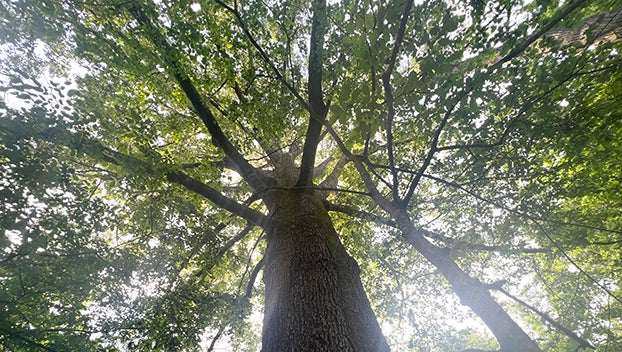Canopy Tour: Question if it is a Southern Red or Cherrybark, look to the leaves
Published 1:30 pm Wednesday, May 24, 2023

- A cherrybark oak towers along the Bayou Pierre in Lincoln County. A member of the red oak family, look to the leaves and cherry tree like bark to identify this tree. (Hunter Cloud | The Daily Leader)
BROOKHAVEN — Slow hunting or fishing days are a great opportunity for outdoorsmen to familiarize themselves with surrounding trees. Canopy tour aims to serve as a guide to different trees you might encounter in the woods in Lincoln County and hope to shed light on what role trees play.
Sweet gums were our first feature due to the fact they are a prolific reproducer and compete with oaks for sunlight in closed canopy systems. Turn your attention next to two species in the red oak family, southern red 0aks and cherrybark oaks.
Southern red 0aks have a high drought tolerance and can live longer than 100 years with a slow growth rate of 35 feet tall at 20 years. Southern reds can grow up to 100 feet tall. Leaves on a southern red resemble a bell.
Mississippi State University Extension Service reports southern red oaks have a strong hard wood with red heartwood and thick white sapwood. Firewood, boxes, barrels, crates and furniture are examples of southern red oak byproducts.
Bark from southern red oaks is high in tannin and was once used to tan leather according to the MSU extension service. Southern reds can be found in uplands on dry ridge tops and well drained slopes.
Acorns from southern red oaks attract squirrels, raccoons, deer, turkeys, woodpeckers, nuthatch and grackles according to the Mississippi Forestry Commission. Fox squirrels prefer the mast crop over 11 of the 12 southeastern oak species.
Cherrybark oaks are a type of red oak which grow at a moderate rate with 60 feet vertical height at 20 years. Leaves on a cherrybark oak resemble the southern red oak’s bell shape but have a more complex shape or “pagoda,” style leaf according to the MSU extension service.
Bark appearance sets the cherrybark oak from other red oak trees. MSU extension writes the cherrybark’s oak when mature resembles a black cherry tree’s bark.
Cherrybark oaks can reach a maximum height of 120 feet to 130 feet. Wood is dense, hard and strong. Heartwood is a reddish-brown and sapwood is thin. Timber from cherrybark oaks are used for veneer, furniture, factory lumber, and other secondary uses such as barrels and crossties, according to the MSU extension service.
While southern red oaks prefer upland sites and ridges, cherrybark oaks prefer well-drained lowland soils in bottomland hardwoods. They will also grow in rich upland sites and loess hills along the Mississippi River according to the Mississippi Forestry Commission.
Wildlife use cherrybark for a variety of purposes. The Mississippi Forestry Commission reports the acorns provide a valuable food to turkeys, waterfowl, blue jays, red-headed and red-bellied woodpeckers, white-breasted nuthatch, common grackle, raccoons, deer and squirrels. Gray squirrels, wild turkeys and blue jays are the heaviest eaters of a cherry bark’s acorn crop.





